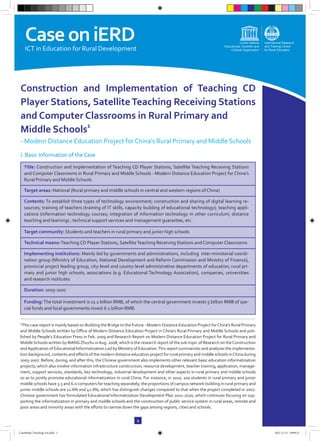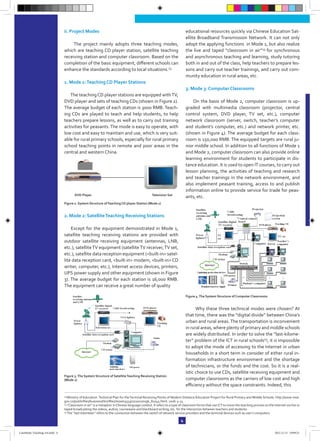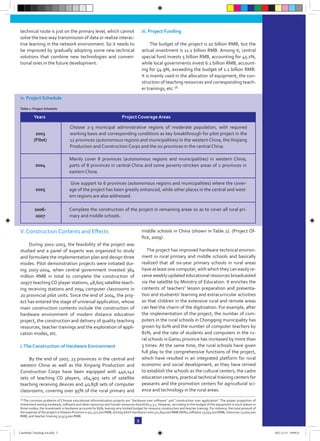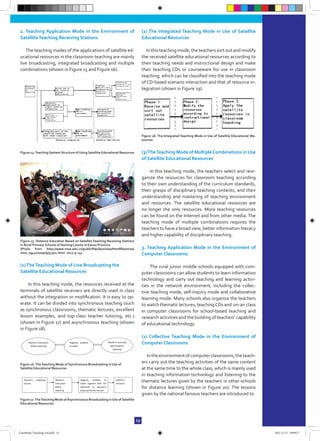The document summarizes a modern distance education project in China from 2003-2007 that aimed to improve education quality and reduce disparities between urban and rural schools. It established teaching CD player stations, satellite receiving stations, and computer classrooms in rural primary and middle schools across China to provide digital learning resources and teacher training. Over 11 billion RMB was invested to equip 360,000 schools. The project helped share quality educational resources with rural students and narrow the digital divide between urban and rural education.



















![4. From Digital to Smart Learning Environment
At the new historical stage of development, the de-
velopment of educational informatization in rural areas
will gradually proceed from the macro to micro construc-
tion and from the expansion of scale to the development
of connotation with more focuses on the capacity build-
ing of the application of educational technology and
how technology can promote the changes of learning
and teaching methods. The construction of the learning
environment is the basis of the changes of learning and
teaching methods, so it is an important direction of the
development of educational informatization in the future
to provide a more convenient, comfortable and effective
learning environment for the learners. It is proposed to
establish smart classrooms and smart campuses in rural
primary and middle schools, construct a public learning
service system and supporting platform based on cloud
computing to achieve the changes from digital to smart
learning environment (Huang R. et al., 2012), provide ap-
propriate learning resources and convenient interactive
tools to automatically record the learning process and
evaluating the learning outcomes, and provide the learn-
ing support services in accordance with the characteris-
tics of learners, etc.
References:
1.CHEN,Q., (2006). Research into theApplication Modes
ofTeaching in the Environment of Modern Distance Edu-
cation in Rural Primary and Middle Schools [J]. E-Educa-
tion Research, (12): 36-38.
2. HUANG, R., (2003).Computer-supportedCollaborative
Learning – Theory and Methods [M]. Beijing: People’s
Education Press
3. HUANG, R., YANG, J. & HU, Y. (2012). From Digital to
Smart: The Evolution and Trends of Learning Environ-
ment. [J] Open Education Research, (1): 75-84.
4. Research Team of the Construction and Application
of Educational Informatization of Ministry of Education
(2010). Research Report on the Topic of the Construction
and Application of Educational Informatization in China
[R]. Beijing: Higher Education Press.
5. LAI, X., (2009). Analysis on the Constraints of Effective
Implementation of Modern Distance Education Project
for Rural Primary and Middle Schools in Mountainous Re-
gions – Investigation on the Implementation of Distance
Education Project for Rural Primary and Middle Schools
inGanzhouCity [J]. Journal ofGannan Normal University,
(6): 92-95.
6. Lv, M., (2007).The Practice, Problems and Solutions to
the Application of “Modern Distance Education Project
for Rural Primary and Middle Schools” [J]. China Educa-
tion Info (04): 7-11.
7. Office of Modern Distance Education Project for Chi-
na’s Rural Primary and Middle Schools (2009). Building
the Bridge to the Future - Modern Distance Education
Project for China’s Rural Primary and Middle Schools[R].
Beijing: People’s Education Press.
8. WANG, Z., (2008). Research Report on Modern Dis-
tance Education Project for Rural Primary and Middle
Schools. Unpublished.
9. WANG, Z., (2009). Outstanding Issues in Modern Dis-
tance Education Project for Rural Primary and Middle
Schools [J]. Distance Education in China, (8) : 61-65.
10. WEI, J., (May 2010). Investigation and Research into
the Implementation Performances of Modern Distance
Education Project for Rural Primary and Middle Schools –
Taking Chang’an District, Xi’an city of Shaanxi Provice as
an Example [D]. Master Dissertation of School of Educa-
tion of Shaanxi Normal University
11. YANG, X. et al. (2008). Cost-benefit Analysis of Mod-
ern Distance Education for Rural Primary and Middle
Schools [M]. Beijing: National Defense Industry Press.
12. ZENG, X., (2011). Review on Modern Distance Educa-
tion Project for China’s Rural Primary and Middle Schools
[J]. China Educational Education (01): 31-35.
13. National Bureau of Statistics of China (2003). China
StatisticsYearbook 2003. Beijing: China Statistics Press.
20
UNESCO International Research and Training Centre for Rural Education
19 Xinjiekouwai Street
Haidian District, Beijing 100875, PRC
Tel: +86 10 58801920/ 58801923
Fax: +86 10 58801920
www.inruled.org
CaseStudy-Teaching-A4.indd 20 2012.11.13 19:09:31](https://image.slidesharecdn.com/f1ef7aa8-9122-4fed-af35-673f388c0809-160815170407/85/CaseStudy-Teaching-A4-20-320.jpg)